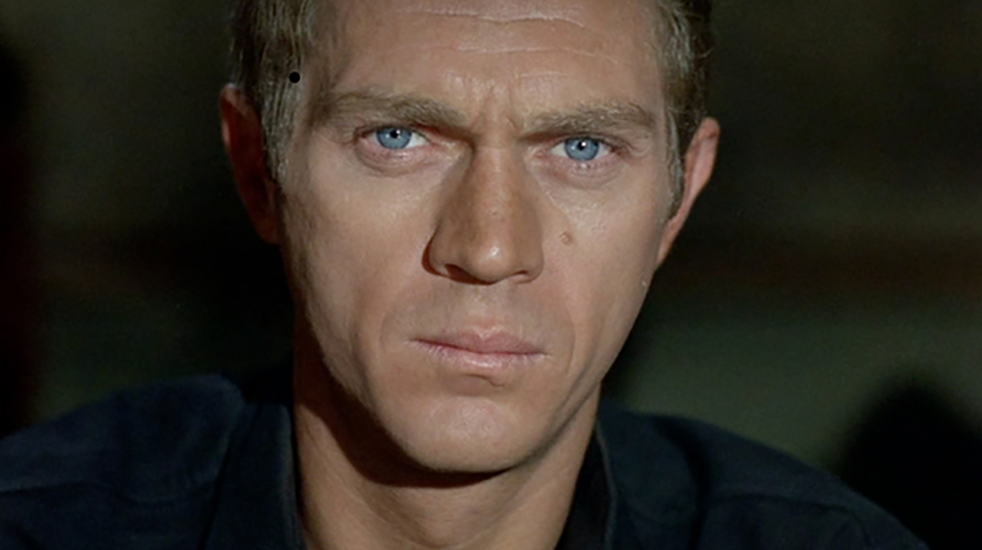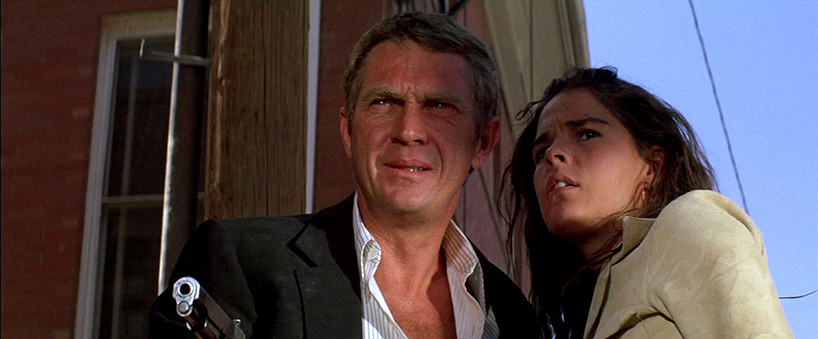Staring Down Our Unseen McQueen Titles
Steve McQueen. For men of a certain age, and plenty of women too, there is no substitute. Revving onto the Hollywood scene in the late 1950s primarily thanks to the TV Western series Wanted: Dead or Alive, the actor’s persona gelled in the early 1960s, and there was no looking back. He effectively filled the on-screen “cool” contingent vacated in death by James Dean and in temporary irrelevance by Marlon Brando.
But McQueen was more than just the cool actor of the moment. He embodied cool. Exuded it. Was it. What many, himself included, would say he lacked in acting ability he more than made up for in sheer presence.
(“I’m not an actor. I’m a re-actor”).
At a glance, he presents as an average man of average build. (This was before the age of ripped action heroes). But McQueen could outdraw, out-drive, and simply out-do any challengers. Steve McQueen lived hard, and entirely for himself; the devil was in his eyes. Ironically and beautifully, then, he would die with Jesus in his heart, distancing himself from the film industry and looking to commit to a newfound selflessness.
Before cancer claimed the life of Steve McQueen in 1980 at the age of 50, he worked for two plus decades as a leading man. In the 1960s and 70s, he was perhaps the biggest movie star in the world. Even as he let his supernova success parlay into an excess of abuse and hard living that eventually killed him, his work was already speaking for itself. His presence alone has elevated, even immortalized many a film that would’ve otherwise long since faded from collective memory. (Would The Great Escape remain a perennial favorite without his particular motorcycle antics?) Today, it still does. A man of few words, his eyes said it all.
Here, we chronologically work our way back from McQueen’s most bloated spectacle, Irwin Allen’s disaster mammoth The Towering Inferno, all the way to his humble beginnings, doing his best James Dean in the schlocky beloved sci-fi horror classic, The Blob. We’ve also got a war film, a poker film, a classic car chase movie, and a grand Western. These are our own heretofore “unseen McQueens”. Be sure to make it to the end, where the first shall be last!
The Towering Inferno
(1974, co-produced by 20th Century Fox and Warner Brothers, dir. John Guillermin)
Reviewed by: David Strugar

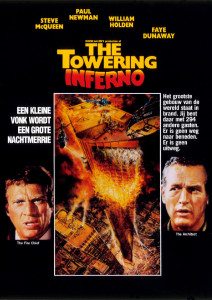 Missed opportunity for tagline: “It’s TITANIC–in a building!”
Missed opportunity for tagline: “It’s TITANIC–in a building!”
Steve McQueen’s name appears in the lower left-hand corner of the screen in the first few moments of The Towering Inferno’s opening titles. In the upper right, Paul Newman is listed. Your eye bounces back and forth between the two names, unsure which one to read first.
Apparently, this was intentional. McQueen and Newman were duking it out behind the scenes over which one of them should get top billing. In the end, the filmmakers compromised and went with the strange diagonal arrangement, so that depending on which way you read it, one or the other man is the lead of the picture.
If I had to cast a vote, I’d go for Newman. His character Doug Roberts begins and ends the movie, and designed the titular building—the Glass Tower, tallest building in the world—and thus has the most personal stake in the disaster that befalls it—a fire that breaks out during the Tower’s gala opening, trapping its 300 party guests on the top floor.
But while McQueen doesn’t show up until at least 45 minutes into the 2-hour-and-45-minute epic, he clearly takes charge as soon as he arrives.
This is not a showy role. As big and blustery as Inferno is trying to be, Steve McQueen’s Fire Chief Mike O’Hallorhan stays cool and collected for the entire ordeal, even when he’s snappily insulting the lack of foresight of the building’s owners (the line “I didn’t think this building could burn,” is actually uttered at one point, thus cementing the Titanic parallels in my head). McQueen is a little older now, a little more seasoned. He’s seen some things. He only makes three or four more films after this one.
He’s not even the smooth, ultra-hip version of cool-and-collected that he’s famous for in his other films. O’Hallorhan is just a guy, an everyman who’s good at his job and keeps showing up to do it every day even though it’s a crazy way to make a living. He’s very much a prototypical John McClane, minus the wisecracks.
McQueen more than earns his billing by the story’s end, his character soaring to the rescue not once but twice by helicopter. The second time epitomizes his character’s unflashy yet indefatigable attitude, as he mostly shrugs at the Navy’s plans to stop the fire, realizing as they explain it that they’re telling him he’s the only guy who can pull it off. He gets back on the helicopter and returns to the top of the Tower to set off an explosion—because, of course an explosion is going to help stop the fire, this is a Hollywood action movie.
It’s a Hollywood action movie that was nominated for eight Academy Awards, including Best Picture, and won three of them.
The Getaway
(1972, Foster-Brower Productions, dir. Sam Peckinpah)
by Paul Hibbard
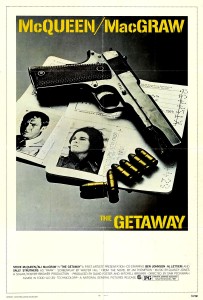 Steve McQueen plays Doc McCoy in the 1972 action/thriller The Getaway. The film has what should be a ridiculous and contrived plot, where corrupt politician Jack Benyon (Ben Johnson) is keeping McCoy in prison, even though he is well past the point he should have been released on parole, until McCoy agrees to rob a bank for him. Eventually, McCoy send his beautiful wife Carol (Ali McGraw) to visit Benyon, where she satisfies his requests along with a few of his other needs.
Steve McQueen plays Doc McCoy in the 1972 action/thriller The Getaway. The film has what should be a ridiculous and contrived plot, where corrupt politician Jack Benyon (Ben Johnson) is keeping McCoy in prison, even though he is well past the point he should have been released on parole, until McCoy agrees to rob a bank for him. Eventually, McCoy send his beautiful wife Carol (Ali McGraw) to visit Benyon, where she satisfies his requests along with a few of his other needs.
The ridiculousness of the setup is reined in by McQueen’s performance that keeps the plot both intense and believable. Everything else on screen may be ultra-violent and extreme (keep in mind it’s directed by Sam Peckinpah), but McQueen keeps it personal and centered with his performance.
The strength of McQueen’s role as McCoy, and of McQueen as an actor altogether, is how much he can get from so minimal. Actor Al Lettieri, playing Rudy, one of the men hired along with Doc to rob the bank, should steal the film from McQueen, and probably would steal the film from most other actors.
But McQueen is not about to let a film be stolen.
Rudy is a psychopath. He is ruthless. He is the toughest guy in most every setting. He’ll kill you without remorse and steal your wife right in front of your eyes, as he does with one couple he meets, played by Harold Clinton and Sally Struthers. After the bank robbery goes wrong, he tells the third man he was hired to rob the bank with, Jackon (Bo Hopkins), to hold the wheel. Rudy then shoots him and throws him out of the car. Rudy then goes to the meeting point, ready to kill Doc and Carol and keep all of the money. Doc and Carol pull up, in love and happy the robbery is over and they now get to move forward in life. Doc casually exists the car and asks Rudy where Jackson is. Rudy replies, “Jackson didn’t make it, and neither did you, Doc.”
Doc then drops the bag he was carrying, revealing a gun in his hand, completely ready for Rudy’s betrayal, and casually and without emotion shoots Rudy in the chest (It’s towards the beginning of the film. Not a spoiler. Don’t worry). He then calmly gets back in the vehicle and leaves.
Which goes to show that Rudy may be a ruthless psycho tough-guy everyone else in the film is scared of, but then one thing he is not and never can be, is Steve McQueen.
Bullitt
(1968, Warner Brothers/Seven Arts, dir. Peter Yates)
by Sharon Autenrieth
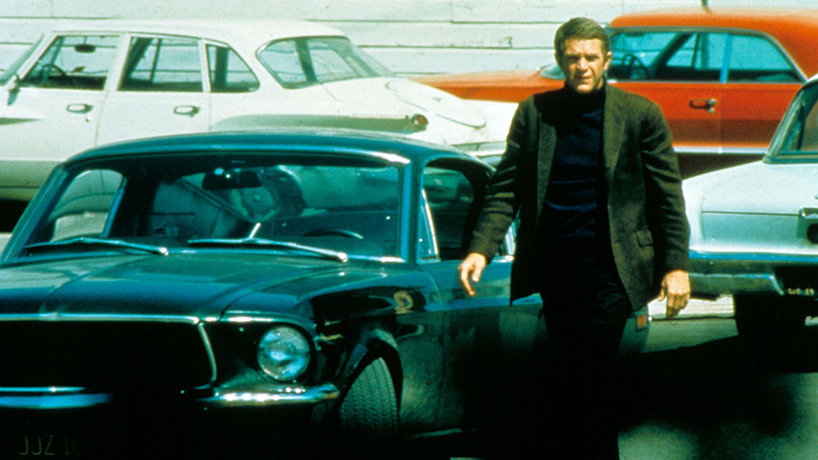
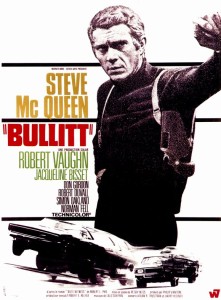 I am not a car person. Proof of this is that early in watching Bullitt I said to my husband, “What kind of car is that?” and he went near apoplectic over my ignorance. “It’s a Mustang! It’s a ’68 Mustang! How can you not recognize a Mustang?”
I am not a car person. Proof of this is that early in watching Bullitt I said to my husband, “What kind of car is that?” and he went near apoplectic over my ignorance. “It’s a Mustang! It’s a ’68 Mustang! How can you not recognize a Mustang?”
My husband spent all of Bullitt identifying the cars aloud. It’s definitely a car-culture movie.
Nevertheless, I enjoyed Bullitt – not for the cars exclusively, but they did factor into what made the move work. Steve McQueen was cool, cool, cool. He was not so much an actor as a personae, and his best movies were ones where the roles fit his established image. In Bullitt he’s a San Francisco cop assigned to protect a mobster-turned-witness. McQueen is lean, blonde, weathered like an aging surfer. His blue eyes are piercing and all of his reactions are careful, low key and wary. When the witness is shot in a carefully guarded hotel room, Lt. Frank Bullitt (that name, though!) finds himself in the cross hairs of both a mob assassin and the senator who is building his career by taking on the mob.
Bullitt is best known for its chase through the streets of San Francisco. It’s long, thrilling, and thoroughly believable. Bullitt’s Mustang and a Charger (transporting the assassin) careen and skid their way through the city and over its famous hills. The cars take a pounding that I could feel in my stomach as I watched. It is, hands down, the best chase scene I’ve ever seen.
The one wrong note in Bullitt was Frank’s relationship with Kath, (Jacqueline Bisset), his artist girlfriend. Her acting was unpersuasive, and Kathy’s histrionic reaction to seeing Frank at work made me want to break up with her myself.
Peter Yates directed Bullitt, and I was fascinated by his patient deliberateness in certain scenes – a surgery, an autopsy, a plane taxiing up to an airport. These scenes seemed like a poke in the eye to the quick cut editing that I have come to expect in action movies. It was anti-style as style, and like Steve McQueen himself the movie was all the more cool for not seeming to care what we think.
The Cincinnati Kid
(1965, MGM, dir. Norman Jewison)
by Justin Mory
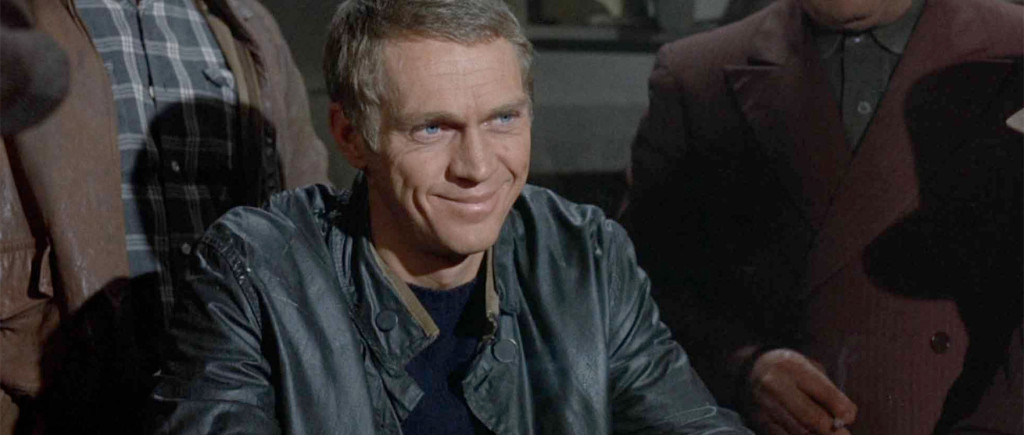
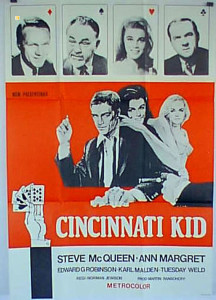 Knowing nothing about poker, 5-card stud, or high-stakes gambling, I nonetheless am able to pick up on a good screen rivalry when I see it, and MGM’s 1965 production of The Cincinnati Kid has enough tension between its two leads to overcome this viewer’s complete ignorance of its subject matter. Steve McQueen as Eric “The Kid” Stoner and screen veteran Edward G. Robinson as Lancey “The Man” Howard face-off against each other in a climactic marathon poker session as fraught with generational enmity as one could expect from a premise that unambiguously announces itself as “The Kid vs. The Man”.
Knowing nothing about poker, 5-card stud, or high-stakes gambling, I nonetheless am able to pick up on a good screen rivalry when I see it, and MGM’s 1965 production of The Cincinnati Kid has enough tension between its two leads to overcome this viewer’s complete ignorance of its subject matter. Steve McQueen as Eric “The Kid” Stoner and screen veteran Edward G. Robinson as Lancey “The Man” Howard face-off against each other in a climactic marathon poker session as fraught with generational enmity as one could expect from a premise that unambiguously announces itself as “The Kid vs. The Man”.
Set in Depression-era New Orleans, and falling somewhere between the earlier The Hustler (1961) and the later The Sting (1973), The Cincinnati Kid of the title is a young man of talent and ability fixated on becoming “the best” in his field of proficiency, with only a pesky old duffer between him and that much-desired title of glory. However, when said duffer stares steely-eyed and imperturbable down the barrel of the lens across the field of battle – in this case, a poker table – directly into the camera’s POV, even the implacable, blue-eyed cool of its equally self-possessed recipient may momentarily wilt under his formidable gaze. As much, if not more, about dramatic conflict as it is about “gutting” one’s opponent, the extra dimension of star-power between McQueen and Edward G. plays on-screen like the New Hollywood contending against the Old, with one or the other finally managing to extract a single dollop of sweat from his screen rival when revealing a game-ending Jack-of-Diamonds.
Surrounded by an astonishing cast, including Karl Malden expertly essaying mid-life pliability between the two rivals, Ann-Margret memorable as a vamp-ish bad girl, Tuesday Weld serviceable as a fair-haired good girl, and a Southern-fried genteel, malevolent Rip Torn – rounded out by marvelous turns from Joan Blondell, Jack Weston, and Cab Calloway, among many others – The Cincinnati Kid adds color and depth to its central conflict, along with its period setting and flavorful locale, in its casting of veteran performers with new. Though it’s up to each viewer to decide which ultimately comes out on “top”, dramatized in Old Hollywood giving way to the New – or vice versa – this mid-60s transitional piece seems to set a tone for what would follow in movie-terms from the latter part of the decade well into the 1970s.
Hell is for Heroes
(1962, Paramount Pictures, dir. Don Siegel)
by Robert Hornak
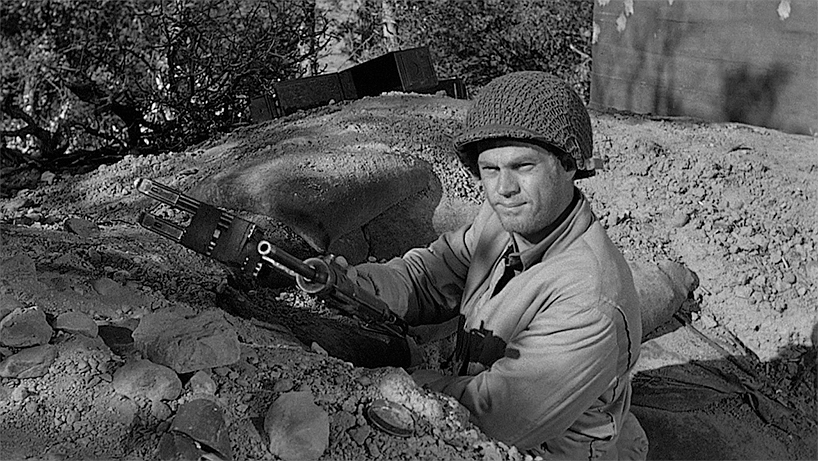
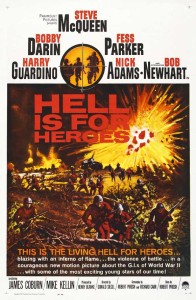 A movie much more straightforward than its theologically dubious title implies. Course, Don Siegel can make nothing but straightforward movies – dad movies, ready-made for rain delays on a Saturday afternoon: The Killers, Madigan, Charley Varrick, Dirty Harry. Even his quintessential ‘50s sci-fi movie Invasion of the Body Snatchers, fashioned as an allegory of social conformity, is about as subtle as a pod person hatching in your bathtub. Like a less-pulpy Sam Fuller, Siegel spoke into existence a no-nonsense universe of cops, cowboys, soldiers, crooks, inmates, gangsters, and punks, all centered by transparent goals, the better to shortcut us to the action, some sinewy filmmaking, and the obvious lessons sometimes not so much learned as stared at.
A movie much more straightforward than its theologically dubious title implies. Course, Don Siegel can make nothing but straightforward movies – dad movies, ready-made for rain delays on a Saturday afternoon: The Killers, Madigan, Charley Varrick, Dirty Harry. Even his quintessential ‘50s sci-fi movie Invasion of the Body Snatchers, fashioned as an allegory of social conformity, is about as subtle as a pod person hatching in your bathtub. Like a less-pulpy Sam Fuller, Siegel spoke into existence a no-nonsense universe of cops, cowboys, soldiers, crooks, inmates, gangsters, and punks, all centered by transparent goals, the better to shortcut us to the action, some sinewy filmmaking, and the obvious lessons sometimes not so much learned as stared at.
Into this canon fits snugly one Steve McQueen. Rock-faced, eyes piercing from under sternly heavy brow, small mouth as likely to grunt out a mumbled spitball of rebuke as nothing at all. In the stoic-yet-combustible garb that’s fitted over McQueen in Hell is for Heroes, Siegel gets to test drive a Harry Callahan prototype up and down an ever-shortening length of WWII’s Siegfried line, where whistling explosions stand in place of blasts from a .44, and a one-man army deploys aggressive ingenuity to coax out enemy Germans instead of slithering hoods. McQueen shows up late amongst a rabble of GIs who’ve just earned their orders home, until circumstances force them back to the front line – cue the moans of frustration, except for our hero, so tightly wound with some grimacing brand of sullen self-hatred and higher-rank-ophobia, that he only shows a glimmer of life when told to join the rest at the front. He’s a hard man to root for – the embodiment of cynical anger over whether war is necessary for anything other than blood-soaked self-immolation, yet cutting a figure so full of distrust and coldness toward his fellow soldiers that receding into the killed column seems the most fitting end.
McQueen’s sour puss illuminates the horror of total war and the quasi-nobility of sacrifice (in this case heavy with the sheen of self-preservation, as he’s also being threatened with court martial), while his less grim co-warriors play out their simpler characterizations with varying levels of turn-of-the-60s believability. James Coburn is a sauntering natural, smart in his round glasses; Fess Parker is the earnest ranking officer who gets to say of McQueen: “When the chips are down, he’s a damn good soldier!”; Bobby Darin is a front-line Mr. Haney, the kid with the crowded-tenement accent who’s got a deal on a watch if you can spare a second; and strangest of all, movie newbie Bob Newhart, who falls backward into the action and actually gets a two-minute “one sided phone call” bit, showing off what he does best, but in a movie that never asked for it. That said, all the rangy pieces do fit together into an entertaining enough movie, but the simple Siegalness of it all makes McQueen’s deep wound seem too heavy for the by-the-book regulations of an otherwise typical war story.
The Magnificent Seven
(1960, The Mirisch Company, dir. John Sturges)
by Jim Tudor
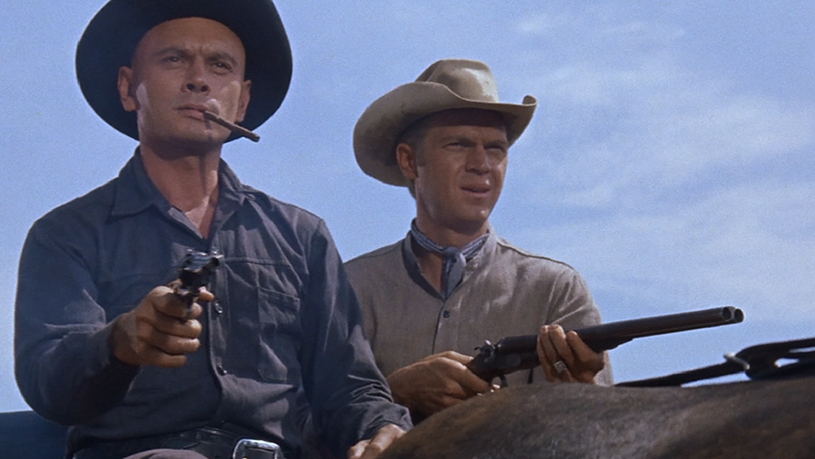
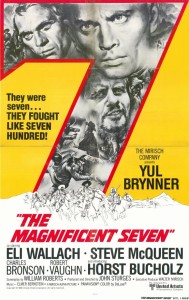 I should’ve seen The Magnificent Seven long ago. No, really – I should’ve! As a senior in high school, I had the privilege of taking a film appreciation class. In it, we spent a week watching Akira Kurosawa’s 1954 masterpiece, The Seven Samurai, and then the 1960 Hollywood Western remake, The Magnificent Seven. Then we had to write a compare/contrast paper. One big problem for me: Despite my best intentions, I dozed through most of the latter film. Fortunately, thanks to the teacher’s extensive lecturing on it, I was able to bluff my way through the assignment. Somehow, over the course of the decades that have followed, I became internally convinced I’d actually seen the whole movie.
I should’ve seen The Magnificent Seven long ago. No, really – I should’ve! As a senior in high school, I had the privilege of taking a film appreciation class. In it, we spent a week watching Akira Kurosawa’s 1954 masterpiece, The Seven Samurai, and then the 1960 Hollywood Western remake, The Magnificent Seven. Then we had to write a compare/contrast paper. One big problem for me: Despite my best intentions, I dozed through most of the latter film. Fortunately, thanks to the teacher’s extensive lecturing on it, I was able to bluff my way through the assignment. Somehow, over the course of the decades that have followed, I became internally convinced I’d actually seen the whole movie.
As I sat a few weeks ago trying to select an unseen McQueen from a smattering of second and third tier films in his filmography, I awoke to the realization that I had in fact not truly seen The Magnificent Seven. I’ve seen it referenced as one of the Great Westerns. No conversation of The Seven Samurai unusually leaves it unmentioned. They hummed the theme on Cheers. I hadn’t seen it. But now, I have!
So, just how magnificent is The Magnificent Seven? I suppose it’s pretty good. Being an adored remake of one of the greatest films in all of cinema, and boasting a curious cast of Yul Brynner, Eli Wallach, Robert Vaughn, James Coburn, and Charles Bronson, the film rides in full of promise.
Handily directed with utilitarian confidence by John Sturges, Seven also had known TV actor Brad Dexter and the hyped German up-and-comer Horst Bucholtz, who would go on to upset James Cagney a year later in the making of Billy Wilder’s manic One, Two, Three! But it was relative newcomer Steve McQueen, in the secondary lead role of the gunslinger Vin, who truly broke out following the success of the film. McQueen’s role is mostly silent, but in true McQueen manor, he owns every frame he’s in (to the apparent chagrin of headliner and project spearheader, Yul Brynner). His brief speech implying the past losses his character has suffered leave an unexpected mark.
But is there a bigger star here than composer Elmer Bernstein? As decent as other aspects of the movie are, Bernstein’s Magnificent Seven theme is the stuff of all-time Hollywood greatness. The music is rousing, impactful, appropriate at every turn, and unforgettable. One of the trailers features an old-timey title song, the type that were so ubiquitous with Westerns of the era. Like “The Man Who Shot Liberty Vallance” by Gene Pitney, the song doesn’t turn up in the film proper. Unlike “Vallance”, it’s had no life beyond. Such is life in the shadow of Bernstein’s theme.
For all that, as a Western fan, The Magnificent Seven, didn’t resonate with me like I wanted it to. Perhaps it’s the remake factor, but unlike Kurosawa’s original, Sturges’ film forsakes any resonant artistry and depth for straight-ahead storytelling. It does that well, but somehow its failure to truly resonate resonated with me more than the film itself. Curiously violent and vaguely international in its casting, The Magnificent Seven is indicative of an action genre on the brink of evolving, and the classic Western tipping its hat one last time.
The Blob
(1958, Paramount Pictures, dir. Irvin S. Yeaworth Jr., Russell S. Doughton Jr.)
by Krystal Lyon
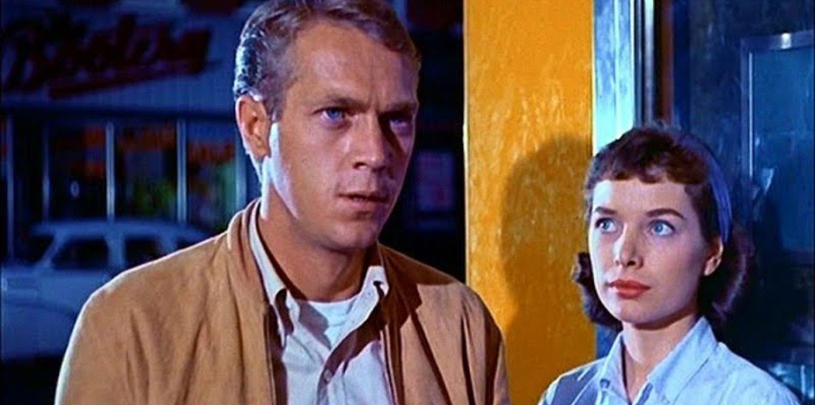
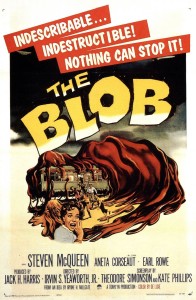 “It Creeps… It Crawls… It Eats You Alive!” For this month’s Film Admission I watched the 1958 classic monster flick The Blob. I recently started watching the horror genre and I wrote about that experience last Halloween in A Beginner’s Guide to Horror Films. I wondered if The Blob would reinforce some key points I learned last fall? So, I popped some popcorn, poured a soda, turned off the lights and settled in for the fun!
“It Creeps… It Crawls… It Eats You Alive!” For this month’s Film Admission I watched the 1958 classic monster flick The Blob. I recently started watching the horror genre and I wrote about that experience last Halloween in A Beginner’s Guide to Horror Films. I wondered if The Blob would reinforce some key points I learned last fall? So, I popped some popcorn, poured a soda, turned off the lights and settled in for the fun!
In The Blob a meteor crashes to earth and interstellar goo oozes out and attaches itself to an old man. After slowly consuming him the parasitic blob goes on to wreak havoc on the small rural Pennsylvania town. The only force that can stop this monster is youths! I have to laugh because it’s not the responsible town doctor or police sergeant that catches on to the horror; nope it’s the local teens that want to see the midnight spooky movie, drag race and make out in the woods. Steve McQueen’s Steve Andrews (one of the teens) asks the question, “How do you get people to protect themselves from something they don’t believe in?” and there’s the main dilemma in The Blob: The codgers won’t listen to the whippersnappers! (Using that 1950’s vocabulary) It’s outrageous and over the top but what else could you want in a Sci-Fi B-movie that will mostly be watched by teens!
It is always interesting to watch an actor’s first starring role. McQueen might be a little stiff and he certainly doesn’t look seventeen but his blue eyes and determination are great and he gets the job done. No doubt his work in The Blob lead to the opportunity to star along side Yul Brynner and James Coburn in The Magnificent Seven just two years later.
Here’s the deal, the point of The Blob is fun! Don’t over think it, honestly don’t try to critique it, just savor the magic. Enjoy the special effects and the gooey blob as it seeps into the local theater. Relish the 1950’s culture and clothes and cars and time warp to a different generation. Be amazed by the color and brilliance of The Blob! The Criterion Collection rereleased The Blob back in 2000 and the super saturated cells are just gorgeous! Also, the blob is kinda the perfect monster! It’s from space, formless, totally silent, locks can’t keep it out and guns can’t stop it. The Blob is just the right amount of cheese, shock and fun and it’s satisfying on every level. And lastly, I will leave you with the baffling question of why can’t women outrun a blob or the undead or a blind mummy or anything else that’s leisurely making it’s way across town?


